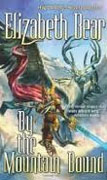By the Mountain Bound
Elizabeth Bear
book reviews:
· general fiction
· chick lit/romance
· sci-fi/fantasy
· graphic novels
· nonfiction
· audio books
· author interviews
· children's books @
curledupkids.com
· DVD reviews @
curledupdvd.com
newsletter
win books
buy online
links
home
for authors
& publishers
for reviewers

 |
By the Mountain Bound Elizabeth Bear Tor Fantasy Paperback 320 pages August 2010 |
|
I’m a fan of Norse mythology, and I really liked reading Thor comics (among others) when I was a boy. That’s why, when I saw By the Mountain Bound
Mingan is the most interesting and complex character in the novel. He is not really an einherjar, but he is a being of the old world, of Valdygard. He used to have the shape of a wolf; now in the form of a man, he is torn between his wolf-like nature and that of an einherjar, or maybe a demigod. He’s like the wolf Fenris (it could be that he’s actually synonymous with Fenris), and he has a ribbon collar around his throat that cuts into him, which he can’t get off despite being more powerful than the other einherjars. He is also called the Suneater, because he ate a sun and the all-Father before being tied up. The ribbon collar was his punishment, and it’s said that one day he will be at Ragnorak and help bring about he end of the world. Mingan is feared by all, even the einherjar: he is strong, powerful, and sometimes unpredictable. He is also, however, kind to humans in trouble, such as victims of assault - until later in the novel, when his adopted wolf pack is slaughtered by humans. An unexpected plot element for me was that Mingan is also Strifbjorn’s homosexual lover, surprising to me because I hadn’t read or heard any mention of this in descriptions of the novel. The sex scenes are handled well, not being overly graphic, but this aspect of the narrative may not be every reader’s cup of tea – especially for those expecting a straightforward action-packed novel involving characters from Norse mythology doing hero-like things like going on quests and fighting for Truth, Justice, and the Norse way of life. Incorporating themes of love, betrayal, jealousy, the plot weaves together the slaughter of innocent wolves and people, usurpation of power, infighting among the einherjars, and a possible upcoming war against the giants. A mysterious woman washes up on shore, nearly drowned, and Strifbjorn gives her CPR - the breath of life. The breath of the einherjars can be used for killing people as well, similar to how succubae act, sucking the souls from the bodies of humans and even other einherjars, but this is generally considered to be against their code of morality and ethics, except during times of war. It’s soon revealed that this woman Heythe is not a mortal and is potentially a Lady prophesied to arrive one day to lead the einherjar in battle. She brings with her the banner of a Raven, posed in a way that suggests (according to the prophesy) that they will ultimately be successful in the war to come - a war against the terrible giants responsible for destroying Valdygard and who pursue her still, attempting to wipe out the children of the Light wherever they may be found. But is she telling the truth, or is she lying about her motive for trying to take over the role of leader from Strifbjorn? By the Mountain Bound If you’ve already read All the Windwracked Stars, you’ll either know or have a pretty good idea of the ultimate outcome. There can be neither winners nor losers, really, when brothers and sisters are pitted against each other in battle. I also wondered why the Grey Wolf either didn’t eat the Lady earlier in the novel, when he was on Strifbjorn’s side, or have his sister Imogen kill her to end the Lady’s attempts to usurp power. He was able to eat the all-Father, whom one would presume to be harder to eat than a lesser goddess like Heythe. If for whatever reason he couldn’t kill her by eating her, then Imogen could - but then there wouldn’t be much of a story. Aside from some niggling questions about why the conflict couldn’t have been resolved some other way and about Bear’s decision to make Strifbjorn and Mingan’s overt sexuality such a prominent part
of the plot, By the Mountain Bound Originally published on Curled Up With A Good Book at www.curledup.com. © Douglas R. Cobb, 2009 |
| Also by Elizabeth Bear: |
|
|
|
 Click here to learn more about this month's sponsor! |
|
| fiction · sf/f · comic books · nonfiction · audio newsletter · free book contest · buy books online review index · links · · authors & publishers reviewers |
|
| site by ELBO Computing Resources, Inc. | |
